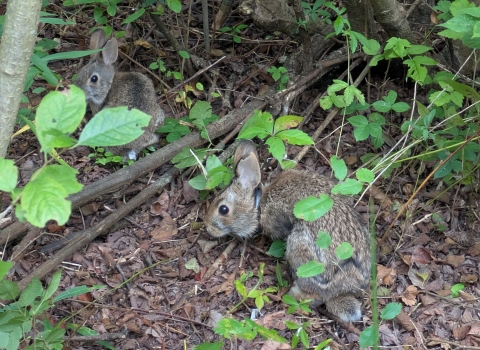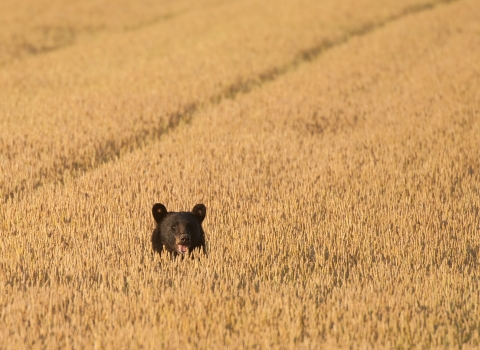What is a dwarf-flowered heartleaf?
The dwarf-flowered heartleaf (Hexastylis naniflora) is a perennial member of the birthwort family, found in 119 populations in North Carolina and South Carolina. It is a small plant, rarely growing taller than six inches high, with dark green, heart-shaped leaves that grow from an underground stem. Its flowers are small, beige to dark-brown, and found at the base of the leafstalk. It has been listed as threatened under the Endangered Species Act since 1989.
Where does it live?
Dwarf-flowered heartleaf is found in Greenville, Spartanburg, and Cherokee counties in South Carolina; and Polk, Rutherford, Cleveland, Gaston, Lincoln, Burke, Catawba, Caldwell, Alexander, and Iredell counties in North Carolina. Typical habitats include moderate to dry bluffs, slopes, or ravines in deciduous forests; or moist soils adjacent to creeks, streamheads, or along lakes and rivers.
What threats has the plant faced?
Dwarf-flowered heartleaf grows in rapidly growing urban areas, including Charlotte, Greenville/Spartanburg, and Hickory. As a result, habitat loss due to development has been the single largest threat to the plant. Other threats include invasive plants and encroachment of native woody plants that shade out the heartleaf.
Why is the U.S. Fish and Wildlife Service proposing delisting?
When the plant was put on the endangered species list in 1989, there were only 24 known populations, distributed across eight counties. Today, there are at least 119 known populations of dwarf-flowered heartleaf, scattered across 10 North Carolina and three South Carolina counties. Of those 119 populations, 27 have more than 1,000 plants, and several are found on protected conservation lands.
In looking at the plant’s future viability, the biologists modeled three scenarios, each reflecting a different level of conservation effort and habitat loss from development. Even in the high-development scenario, it’s predicted 56 of these populations would have moderate or better viability, with 27 of those having very high viability.
What contributed to its recovery?
Key to the heartleaf’s recovery were efforts by a wide variety of organizations to conserve the species and its habitat, including:
- Foothills Land Conservancy
- Catawba Lands Conservancy
- The Nature Conservancy
- National Park Service
- Broad River Greenway
- North Carolina Department of Transportation
- Duke Energy
- Private landowners
- State of North Carolina
The world’s largest population is currently conserved by private individuals, and the most significant contribution to the plant’s conservation came from the N.C. Department of Transportation.
How was the decision made to propose delisting?
The Service brought together a team of biologists, who compiled and examined all known data and research regarding the plant. The outcome was a peer-reviewed summary of its historic and current status, as well as projections of population stability and future trends. This Species Status Assessment formed the foundation for the Service’s decision to propose removing this plant from the federal threatened and endangered species list.
How do I comment on the proposed delisting?
Electronically: Go to the federal eRulemaking Portal In the Search box, enter FWS–R4–ES–2019–0081, which is the docket number for this rulemaking. Then, click on the Search button. On the resulting page, in the Search panel on the left side of the screen, under the Document Type heading, click on the Proposed Rules link to locate this document. You may submit a comment by clicking on “Comment Now!” or
Submit hard copies by U.S. mail or hand-delivery to:
Public Comments Processing
Attn: FWS–R4–ES–2019–0081
U.S. Fish & Wildlife Headquarters, MS: BPHC
5275 Leesburg Pike
Falls Church, VA 22041-3803
The Service will accept and consider comments and information that is received or are postmarked on or before June 25, 2021. The agency must receive comments submitted electronically using the federal eRulemaking Portal by 11:59 p.m. Eastern Time on the closing date.
Please send your comments only by the methods described above. Verbal comments left on phone voicemail or comments sent to other postal or email addresses will not be accepted. The Service will post all information received on regulations.gov. This generally means that the Service will post any personal information you provide.
Where can I learn more about the dwarf-flowered heartleaf?
Information is available on the Asheville field office website or you may contact the U.S. Fish and Wildlife Service’s Asheville North Carolina Field Office at:
Janet Mizzi, Field Supervisor
Asheville Ecological Services Field Office
160 Zillicoa St.
Asheville, NC 28801
Phone: 828-258-3939
If you use a telecommunications device for the deaf (TDD), call the Federal Information Relay Service (FIRS) at 800-877-8339.




